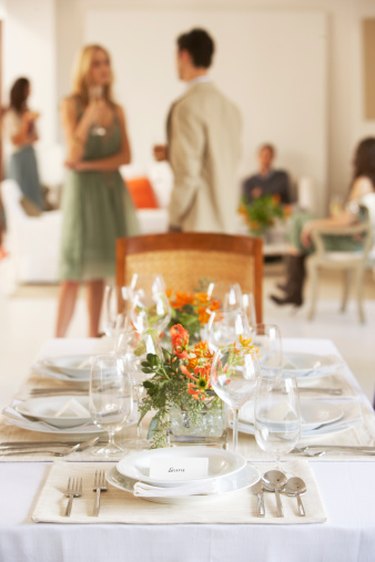Things You'll Need
Tablecloth
Dinnerware
Cloth napkins
Glasses
Flatware

Whether your home's decor calls for an European-style table setting or you are serving European cuisine to your guests, knowing how to set a table in an European style can be very helpful. Additionally, when you are hosting a formal dinner European style, implementing the rules of European dining etiquette leaves a positive impression on the attending guests as well as sets them at ease. Formal social events are often important, and the confident execution of European table settings and service is a worthy skill; the mastery of the details of the table setting reflects a respect for your guests' cultural differences.
Step 1
Lay an appropriately themed tablecloth on the dining table. Coordinate your choice of tablecloth with the design of the dinnerware and the table's centerpiece to ensure that they complement each other.
Video of the Day
Step 2
Identify the position of each place setting by setting down service plates. Remember that food should never touch these dishes; rather, they serve as a base for each course of the meal, and are not removed or exchanged. Allow each guest a spacing of 24 inches, or 2 feet.
Step 3
Place the dinner plate directly on top of the service plate, doubling the dinner plates to two if you plan to serve more than one main course.
Step 4
Position cloth napkins on the dinner plate(s); fold them in a simple triangle or square shape to enforce the impression that they have not been handled. Place the napkins immediately to the right of the service plates in a napkin ring if the first course is already served when guests are seated; never require guests to move china and food to retrieve their napkins. Placing the napkin in the water glass or on the service plate is a French custom and serves as an interesting variation if space is limited.
Step 5
Place glasses above and to the right of the dinner plate, reflecting each beverage and type of wine served. Place the water goblet closest to the plate, followed by the red wine glass and finally the white wine glass. Position the champagne flutes and/or the small dessert wine glass together, if applicable, locating them a small distance further and above the other glasses.
Step 6
Set knives to the right of the service plates, blades turned with the serrated edge toward the plate, and the dinner spoon to the outside of the knife/knives with the concave side up.
Step 7
Place the round, deep soup spoon to the outside of the dinner spoon when soup is on the menu.
Step 8
Position the fork(s) on the left side of the service plate in the order that they will be used. For example,.include the shorter salad fork between the longer dinner fork and the service plate if you will be serving salad and/or antipasto after the main dinner courses.
Step 9
Place a small dessert fork above the service plate, handle to the left; set a dessert spoon directly opposite and facing the dessert fork, when applicable. Position the fruit fork immediately below the dessert fork, handle to the left, and accompanied by a fruit knife opposite the dessert fork's tines with the handle to the right.
Step 10
Reserve space for a bread plate to the upper left of the service plate and lay a butter knife horizontally across the upper part of the bread plate, blade pointing left with serrated edge facing down.
Step 11
Set a coffee/tea service, complete with a saucer and stirring spoon resting on top and to the right of the cup's handle, on the right side of the service plate yet under the beverage glasses to indicate to your guests that a hot beverage will be served.
Tip
Remember that European and American cultural differences affect the order in which to serve courses; Europeans traditionally serve salads after the main course, not before as in American culture.
European dining etiquette dictates the use of flatware from the outside to the inside; keep this rule in mind as you plan the order of the courses.
Maintain a distance of 2 inches from the edge of the table for place settings.
Video of the Day